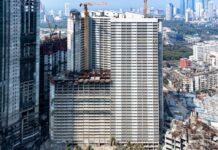May 21, 2015
Frequencies of the earth have been changing quite a lot recently giving precautionary measures to all. Earthquakes are trending majorly in day to day discussions, social forums and the media due to its constant frequency. The natural calamity is increasingly becoming a nightmare for everyone which is why it is also important to know about the preparatory methods to face such a disaster.
The vibrations caused by the rocks breaking under stress are moving the underground surface. This depends on many factors such as magnitude, distance from the epicenter, depth of focus, topography and local ground conditions. If the people or buildings are on soft ground such as old river sediments, the intensity experienced might be one to two units higher. Again on solid rock, it might be one unit lower. The intensity with which the earthquake is felt may also be higher on hilltops such as it happened recently in Nepal with a high magnitude of 7.7MM. Earthquakes under sea can cause a tsunami or a series of waves which can cross an ocean and cause extensive damage to coastal regions. Earthquakes are common occurrences rumbling below earth’s surface. Even after earthquake we often come across aftershocks which are disadvantageous. Here are some steps which can be taken to prevent earthquake and such calamities.
 It is extremely crucial in the current frequency of earthquakes that one should take some important and drastic measures for our existence. Considering the buildings, it is also vital to create them with materials which are highly ductile. Materials like bricks and concrete absorb very little energy which is why it is not recommended to that they be used to make a building which is earthquake proof. For example: The world’s tallest building Burj Khalifa is made out of a very unique concept, consisting of a tabular system embedded with structural steel.
It is extremely crucial in the current frequency of earthquakes that one should take some important and drastic measures for our existence. Considering the buildings, it is also vital to create them with materials which are highly ductile. Materials like bricks and concrete absorb very little energy which is why it is not recommended to that they be used to make a building which is earthquake proof. For example: The world’s tallest building Burj Khalifa is made out of a very unique concept, consisting of a tabular system embedded with structural steel.
Apart from this, important elements to focus on are the roof and the floors of the buildings which should be made as light as possible. The light and flexible structure of the buildings should be able to absorb the energy so that it can prevent the buildings from getting damaged.
There have been engineers and seismologists who are favoring base isolation for years to protect buildings from earthquakes. To design structures which can withstand earthquakes, engineers should understand the stresses caused by shaking. Following are the preventive steps to sustain the buildings from such misfortunes:
- Building codes provide the first line of defense which are against future earthquake damage and help to secure public safety.
- The variety of different types of cylinders but rigid lead core wrapped in alternating layers of rubber and hardened steel provides strength horizontally.
- Seismic floor can be used to prevent the ill effects caused by earthquakes. Seismic Floor is designed with a cover plate that has an inverted bevel which reduces the gaps between the cover plate and extension plate. It is a reliable and durable system of interior flooring which is capable of accommodating multi-directional and thermal seismic movement. The emergency checkups should be done frequently.
- Another tried and true technology to help the buildings is the shock absorber which controls unwanted spring motion in the car. Shock absorbers reduce the magnitude of vibratory motion which turns down the kinetic energy of bouncing suspension into heat energy that can be debauched through hydraulic fluid. This is called damping and people prefer shock absorbers as dampers and these dampers are used to build earthquake-resistant buildings. When an earthquake as strikes, the horizontal motion of the building causes the piston in each damper to push against the oil, transforming the quake’s mechanical energy into heat.
- In many modern high-rise buildings, core-wall constructions are used to increase seismic performance at cheaper cost. The reinforced concrete core runs through the structure, surrounding the elevator banks. The extremely tall buildings and the core wall can be substantial with at least 30 feet in each plan direction and 18 to 30 inches thick.
- As the old building constructions are very fragile, firm fixation of the tall and heavy furniture can be done with the wall.
- The plasticity of materials presents a major challenge to the engineers who are trying to build earthquake-resistant structures.
 During the past 30 years, skyscrapers have been constructed by the engineers that float on very unique systems of, springs, padded cylinders and ball barring. Acting like shock absorbers in a car, these systems allow the building to be decoupled from the shaking of the ground. To consider earthquake resistance building a new structure is important, but retrofitting old buildings to improve their seismic performance is just as important. The other ways to make the buildings earthquake resistant are wood structures; extra strapping can be nailed to the key parts of the frame. Steel reinforced concrete is another option with the strengths and weaknesses of each compound offsetting the other.
During the past 30 years, skyscrapers have been constructed by the engineers that float on very unique systems of, springs, padded cylinders and ball barring. Acting like shock absorbers in a car, these systems allow the building to be decoupled from the shaking of the ground. To consider earthquake resistance building a new structure is important, but retrofitting old buildings to improve their seismic performance is just as important. The other ways to make the buildings earthquake resistant are wood structures; extra strapping can be nailed to the key parts of the frame. Steel reinforced concrete is another option with the strengths and weaknesses of each compound offsetting the other.
The purpose of the prevention is to keep our environment safe providing people with security and people could take an evasive action. Earthquakes are very disruptive because they occur suddenly. As it occurs without warning, it’s always better to be prepared in advance.
Author : Sanjay Khorana
The author is Senior Vice President of Tashee Group, one of the most preferred real estate brands spread across high-end commercial complexes, residential developments, retail spaces, office, Mega Township etc since its inception in 2004 headquarter in Delhi. Over the last 10 years, the group has a business interest in Real Estate, Entertainment Industry, Hospitality, and Care Home as an executer of some real estate projects and producer of several upcoming tele-serials respectively in India.
CCI Newswire























